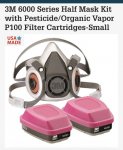Teltech is correct, read the data sheet. If you use the DP- 401 activator there is an induction period that must be adhered to. If you use the quicker -402 activator there is no induction time.
Think i will check to see what's left on ebay. Only thing to keep in mind is that epoxy will become seedy over time. ( looks like tiny specks of sand are in your paint ) I'm just not sure if it happens to an unopened can or if air is the cause.
I've found the DPLF flows *much* better with that optional acetone in the mix, I don't even use the full 1/2 part but just a splash seems to help a lot.
The stuff I got was 44GN011 Water Reducible Epoxy Primer and only about 1 month expired.
It's water-reducible so I'm not totally sold on using it on bare steel, but over paint it's perfect.
In my case I have an aluminum hull I've been prepping and had been gritting my teeth preparing for what a couple gallons of aluminum compatible primer was going to cost me. So... win! It's odd to mix and follow the instructions but otherwise I've been using it for all sorts of things with good results.
I also bought some of the Desothane HS CA8100 Anti-Chafe Topcoat which has been very cool, comes in a light gray and thus far has been great, chemical resistant and stuff just wipes off. It's miserable to sand though, not surprising since it's full of PTFE!
For those unaware, all PPG paints have a P-sheet, the technical instructions for use of the product and well worth the brief time to download and read! It's also the case the Anest Iwata and perhaps others have actually gone to the effort to produce spraying guidelines for common finishing products with their equipment, also very helpful in setting up to spray if you haven't used a product before.



